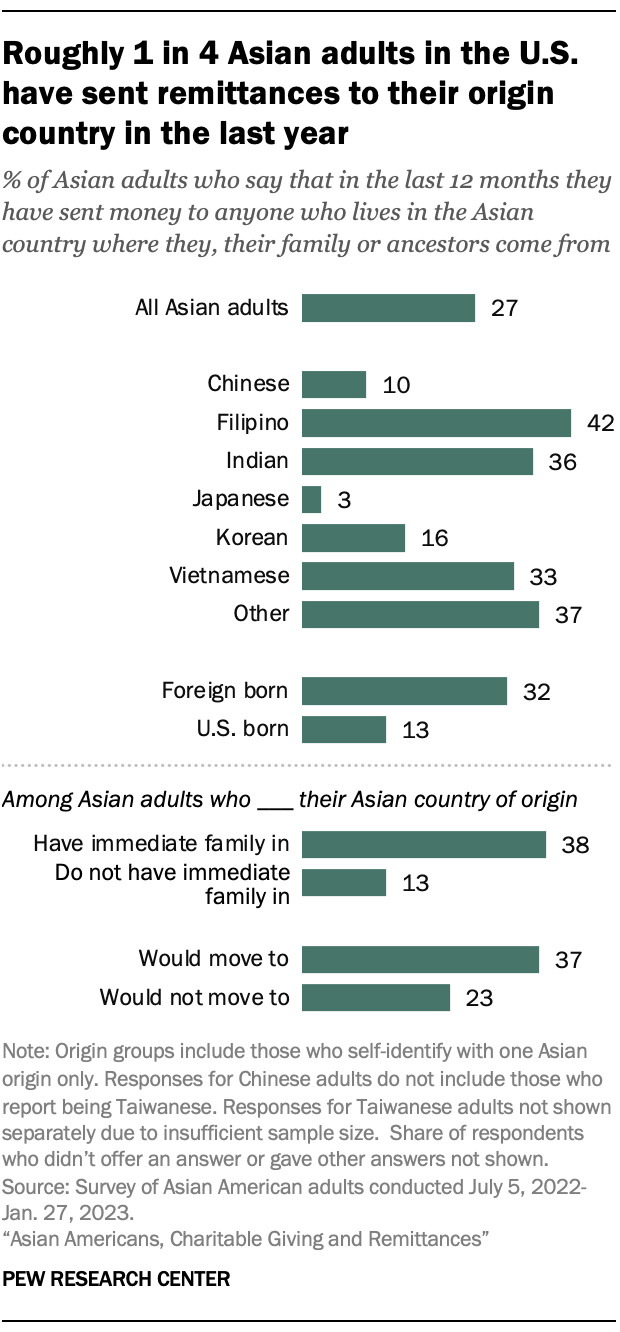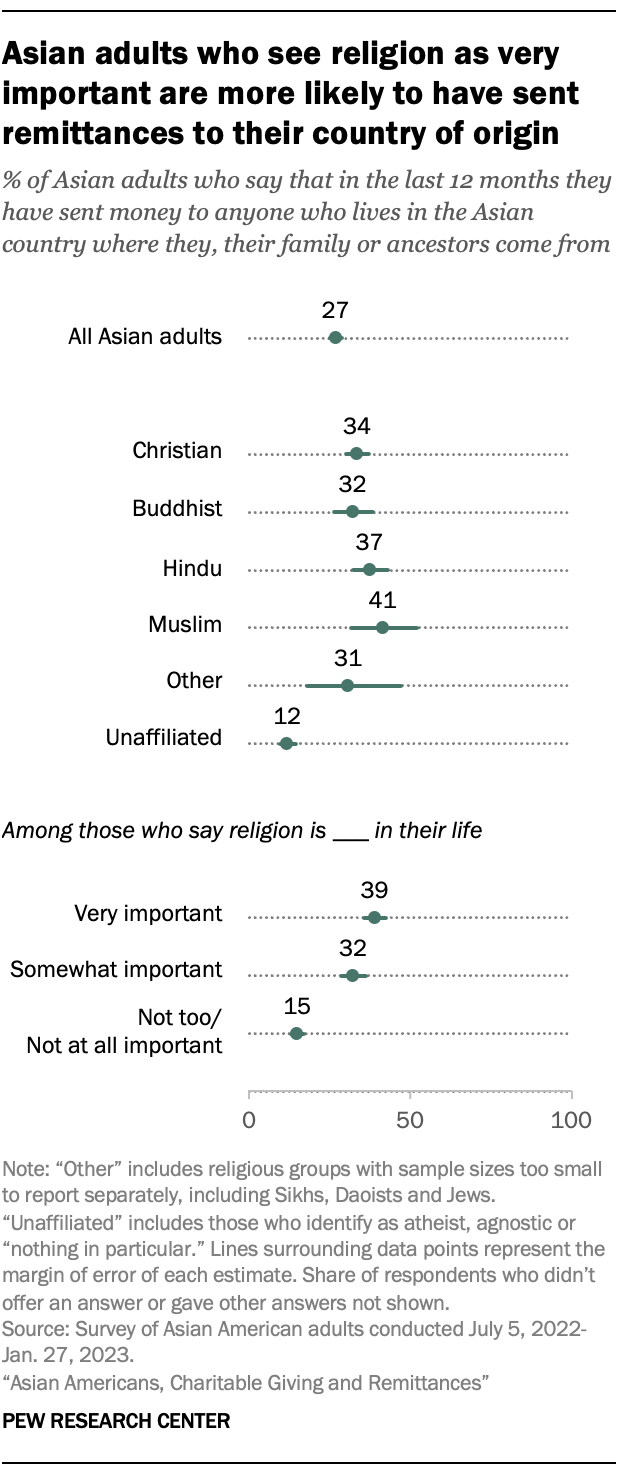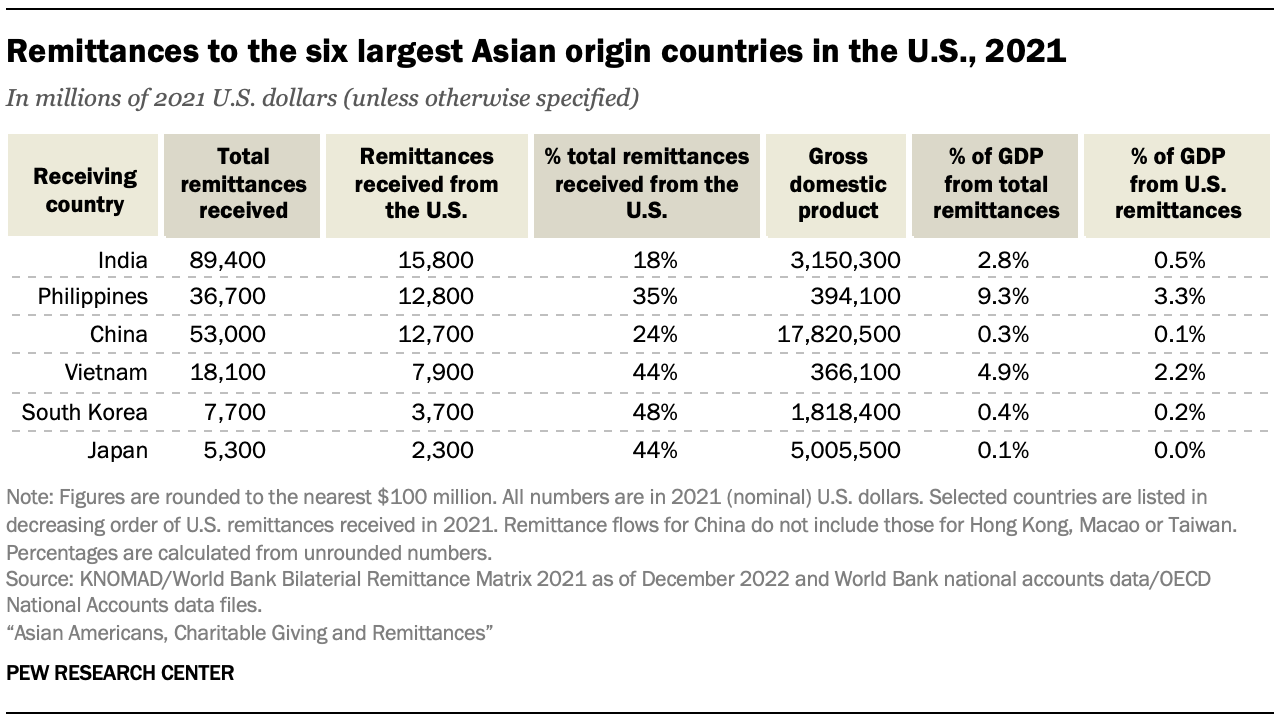In addition to asking Asian adults whether they have given to charitable organizations, we asked whether they have sent remittances – personal monetary transfers to someone living in the Asian country where they, their family or ancestors are from.

About a quarter of Asian adults in the United States say they have sent remittances in the year before the survey, which was conducted July 2022 to January 2023. Among those who have, the most common reasons for doing so are to help with ordinary expenses – like food and clothing – and health expenses.
Which Asian Americans send remittances?
Overall, 27% of Asian adults in the U.S. say they have sent money to someone in the Asian country they or their ancestors are from in the 12 months prior to the survey.
By origin
Among the six largest Asian origin groups in the U.S., Filipino (42%), Indian (36%) and Vietnamese (33%) adults are the most likely to say they have sent money to anyone living in their ancestral homeland. Chinese (10%) and Japanese (3%) adults are the least likely to say this.
By nativity
Asian immigrants are more than twice as likely as U.S.-born Asian adults to say they have sent remittances in the 12 months before the survey (32% vs. 13%).
Among immigrants, those who arrived in the U.S. more recently are somewhat more likely than longtime residents to say they have sent remittances:
- 37% of Asian immigrants who have lived in the U.S. for 20 years or less say they have sent remittances in the last year.
- 28% of Asian immigrants who have lived in the U.S. for more than 20 years say the same.
Among those born in the U.S., third- or higher-generation Asian Americans are the least likely to say they have sent money to someone in their Asian country of origin. Only 4% say they have done so, compared with 15% of second-generation Asian adults.
By ties to ancestral homeland
Among Asian adults who have immediate family living in their Asian ancestral homeland, 38% say they have sent remittances in the last year. A much smaller share of those who do not have family there (13%) say the same.
The survey also asked Asian adults whether they would move (or, in some cases, move back) to the place in Asia they or their ancestors are from. Remittance patterns differ by their answers to this question:
- Among Asian adults who say they would consider moving to their Asian country of origin, 37% say they sent remittances in the year before the survey.
- Among those who would not consider moving there, 23% say the same.
By education and income

There are no large differences by education or income in whether Asian Americans have sent remittances to their country of origin. Across these groups, about three-in-ten or fewer say they have done so in the year before the survey.
For example, 30% of those with a high school diploma or less and 26% with a postgraduate degree say they sent money. Likewise, similar shares of those with a family income of less than $30,000 and those with a family income of $150,000 or more say the same (20% and 26%, respectively).
By religion
Across major religious groups, Asian adults who are religiously unaffiliated are the least likely to say they have sent money to anyone who lives in their Asian country of origin.
Similarly, remittance sending is linked to how important religion is in Asian Americans’ lives:
- 39% of Asian adults who say religion is very important in their life have sent remittances in the 12 months before being asked.
- 15% of Asian adults who say religion is not too or not at all important have done the same.
Why do Asian Americans send remittances?
Among Asian adults who have sent money to someone in their Asian ancestral homeland in the year before the survey, the most common reasons are to help with ordinary expenses like food and clothing (63%) and health expenses (50%).
Smaller shares of Asian adults who sent remittances say they have sent the money for a marriage or funeral (35%); for a large purchase, like appliances or home improvements (19%); or to save or invest (16%). Fewer than one-in-ten say the money was for importing products or services to the U.S. (7%) or for a business outside the U.S. (6%). Additionally, about a third of Asian adults (36%) say they sent remittances for another reason not specified in the survey. (The survey did not ask respondents what that reason was.)
Among Asian adults who sent remittances, there are some demographic differences in the reasons for sending money.
By origin
Korean adults are less likely than Filipino, Indian and Vietnamese adults to say they sent remittances for ordinary expenses, health expensesor a large purchase.3 Among those who say they have sent remittances in the year prior:
- 28% of Korean adults say they sent money for ordinary expenses, compared with 72% of Filipino, 61% of Indian and 61% of Vietnamese adults.
- 21% of Korean adults sent money for health expenses, compared with 55% of Filipino, 56% of Indian and 42% of Vietnamese adults.
- 4% of Korean adults sent money for a large purchase, compared with 28% of Filipino, 18% of Indian and 14% of Vietnamese adults.
By family ties
Asian adults with immediate family living in their Asian country of origin were more likely than those without family there to say they sent money for a large purchase (22% vs. 11%).
By education
Asian Americans with some college experience or less were more likely to say they sent money for a marriage or funeral, compared with those with a bachelor’s degree or more (42%. vs. 29%).
Remittance flows from the U.S. to Asian origin countries
The U.S. is by far the world’s largest remittance-sending nation, in part because it also has the largest immigrant population of any country. In 2021, Asian Americans’ places of origin collectively received about $63 billion in remittances from the U.S.4 The Asian countries that are the largest receivers of U.S. remittances broadly coincide with the most common origin countries for Asian Americans – India, the Philippines, China, Vietnam, South Korea and Japan. These six countries received about $55 billion from the U.S. in 2021.5
India, the Philippines and China were also among the five largest receivers of U.S. remittances globally in 2021. Each country received over $10 billion in remittances from the U.S. that year. Vietnam, Korea and Japan received less in remittances from the U.S., but remittances from the U.S. made up a larger share of total remittances received by each of these countries in 2021 (over 40%).

Overall, remittances generally do not make up significant shares of these Asian origin countries’ overall gross domestic product. The exception is the Philippines, where nearly one-tenth (9.3%) of the country’s economy came from migrant remittances in 2021, and 3.3% came from remittances sent through the U.S. alone.
Many Asian origin countries, such as the Philippines and India, have developed programs to recognize their diasporas living abroad and their potential contributions to the country, including through remittances.




